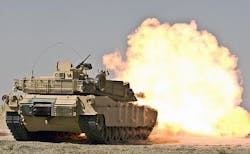Near-peer conflict bringing back heavy armored combat vehicles, and with it more vetronics upgrades
THE MIL & AERO COMMENTARY – The last decade of the 20th Century brought waves of change to the U.S. military after the Berlin Wall came down in 1989, when Pentagon leaders adjusted to a post-Soviet world and the presumed end of the Cold War. One of the big changes involved U.S. heavy armored combat vehicles.
Rather than continuing their dependence on heavy iron like the M1 Abrams main battle tank, the M2 Bradley Fighting Vehicle, and the M109 Paladin self-propelled howitzer, the U.S. Army and Marine Corps moved toward lighter armor with tires instead of treads, like the M1126 Stryker interim combat vehicle, the Mine Resistant Ambush Protected (MRAP) vehicle, the LAV-25 light armored vehicle, and the M1128 Mobile Gun System.
It made sense at the time. Those lighter wheeled combat vehicles are easier to transport quickly by aircraft than their heavier, tougher tracked brethren like the Abrams and the Bradley. These vehicles and their vetronics were less expensive, and the lighter vehicles were better suited for the emerging global war on terror. The Cold War was over, and retooling of U.S. mechanized land forces retired the notion of U.S. and Western military forces going toe-to-toe with Soviet armored forces in Central Europe.
At the time, moreover, U.S. military planners were eager to reap the economic benefits of ending the Cold War -- just as they were after World War II, Korea, and Vietnam.
As the new light wheeled combat vehicles and their electronics upgrades started entering the force two decades ago, I couldn't help wondering if the era of the heavy tank was over. Yes, the Soviet Union had transformed into Russia, but was there no need for the Abrams tank if some conflict unexpectedly flared up? The name of that country changed, but there were still plenty of Russian-made T-72 tanks left in the world.
I remember shuddering at the thought of a battle between Russian T-72s and U.S. Strykers. The ignominious U.S. defeat in the 1943 Battle of Kasserine Pass in North Africa comes to mind. The German Tiger tanks had 88-millimeter high-velocity guns that made quick and gruesome work of the U.S. M3 light tanks with 37-millimeter main guns, and allied forces were pushed back for 50 miles. A force-on-force engagement of Strykers and T-72s wouldn't be much different.
Today, however, it's a different era, as U.S. military planners tighten their focus on the possibility of peer and near-peer conflicts with military powers like Russia and China, and with this new day we are seeing the return of heavy armor.
The 1st Brigade Combat Team of the Army's 1st Armored Division at Fort Bliss, Texas, next spring is switching their Stryker light armored vehicles for upgraded Abrams tanks. The 2nd Brigade Combat Team of the Army's 4th Armored Division at Fort Carson, Colo., are transforming their unit from an infantry brigade to a Stryker brigade in spring 2020, adding about 500 personnel and hundreds of Strykers.
Last year the 2nd Brigade Combat Team of the 3rd Infantry Division at Fort Stewart, Ga., switched from an infantry brigade combat team to an armored brigade combat team, adding 18 Paladin self-propelled howitzers, 138 Bradley fighting vehicles, and 87 Abrams tanks.
Sounds like the era of heavy armor is far from over. Depending on whom you talk to, a new era of heavy armor might be just getting started.
What are the technological ramifications of such a trend? Combat vehicles aren't just collections of firepower anymore; they're nodes on tactical battlefield networks. A renewed emphasis on heavy armor will mean upgrades in communications, networking, sensors, displays, digital signal processing, and more.
The new emphasis on peer and near-peer conflict, and with it the return of heavy armored combat vehicles, will continue vast opportunities for the defense electronics industry, and combat vehicle upgrades with the latest generations of electronics technologies.
Ready to make a purchase? Search the Military & Aerospace Electronics Buyer's Guide for companies, new products, press releases, and videos

